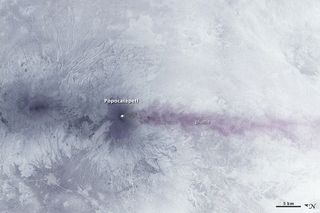
Satellite Captures Mexican Volcano's Unceasing Eruption

Mexico's Popocatépetl volcano, the second-highest in North America, is still sending up plumes of gas and fine ash, but with a decreased vigor following more than a week of a rather dramatic uptick in activity.
This ghostly image, captured by a NASA satellite, shows the erupting Popocatépetl at night. It's a thermal image, snapped at 10:53 p.m. local time on April 25, 2012. The lighter areas are warmer, the darker areas are cooler. The white dot in the center of the image is a hotspot within the volcano's summit crater.
Although the mountain has been erupting at a low level since January 2005, the volcano began emitting a substantial amount of ash on April 12 this year, and an explosion on April 13 sent volcanic rocks as far as 1,640 feet (500 meters) away from the crater rim.
A NASA video shows a plume of ash emanating from the volcano over the course of week, from April 14 to April 22.
Today (April 26), the mountain has been relatively calm, according to CENAPRED, the Mexican monitoring authority, yet the volcano alert level remains at a Yellow Stage 3.
This means that the awakened volcano could still potentially erupt with further violence, and the agency is recommending that a safety radius of more than 7 miles (12 kilometers) be maintained around the mountain.
Popocatépetl, whose name means "smoking mountain" in Aztec, is 17,802 feet (5,426 m). It is second to Mexico's Pico de Orizaba, at 18,491 feet (5,636 m), which is also the highest volcano in North America.
Sign up for the Live Science daily newsletter now
Get the world’s most fascinating discoveries delivered straight to your inbox.
Popocatépetl's last major eruption occurred in 800 A.D., during which vast amounts of lava and ash from the volcano completely filled many of the surrounding valleys. Since then, there have been at least five moderate eruptions, two of which occurred in the 1900s.
Follow OurAmazingPlanet for the latest in Earth science and exploration news on Twitter @OAPlanet and on Facebook.
Most Popular

